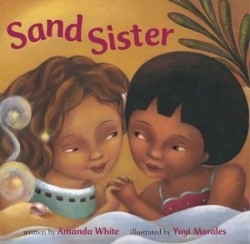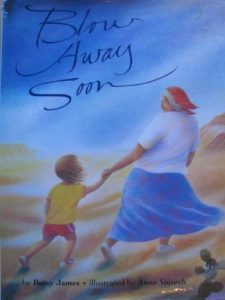 Disliking the wind that whisks away her favorite possessions, Sophie appeals to her grandmother for help and is instructed on how to build a blow-away-soon, an appeasing gift for the wind, in a story about keeping and giving away.
Disliking the wind that whisks away her favorite possessions, Sophie appeals to her grandmother for help and is instructed on how to build a blow-away-soon, an appeasing gift for the wind, in a story about keeping and giving away.
Early Years (ages 2-6)
Sand Sister
No Dogs Allowed!
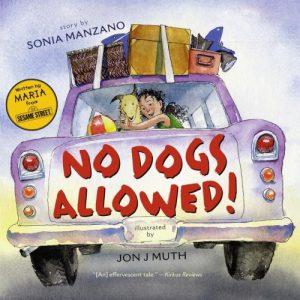 Sometimes the unexpected is even more fun than the best-laid plans. Iris, her family, the neighbors, and dog take a road trip to the lake. But first, the cars break down. Then they get lost. And when they finally arrive at the lake, they see a NO DOGS ALLOWED sign. What to do? Iris’s family’s make-do attitude saves the day, for as they go about their beach activities while trying to figure out what to do with the dog, each takes a turn taking care of the dog. Soon the day is over, and the dog has had the best time of all — the beach had been brought to him. Sesame Street’s Sonia Manzano’s first picturebook provides an ocean of humor, a warm, close-knit Puerto Rican community, and a take-charge family who refuses to let things get in their way!
Sometimes the unexpected is even more fun than the best-laid plans. Iris, her family, the neighbors, and dog take a road trip to the lake. But first, the cars break down. Then they get lost. And when they finally arrive at the lake, they see a NO DOGS ALLOWED sign. What to do? Iris’s family’s make-do attitude saves the day, for as they go about their beach activities while trying to figure out what to do with the dog, each takes a turn taking care of the dog. Soon the day is over, and the dog has had the best time of all — the beach had been brought to him. Sesame Street’s Sonia Manzano’s first picturebook provides an ocean of humor, a warm, close-knit Puerto Rican community, and a take-charge family who refuses to let things get in their way!
Three Little Tamales
While three little tamales cool off on a windowsill, a tortilla rolls by. “You’ll be eaten. You’d better run,” he tells them. And so the tamales jump out the window. The first runs to the prairie and builds a house of sagebrush. The second runs to a cornfield and builds a house of cornstalks. The third runs to the desert and builds a house of cactus. Then who should come along but Senior Lobo, the Big Bad Wolf, with plans to blow their houses down. Valeria Docampo’s oil-and-pencil illustrations add zest and humor to this rollicking southwestern version of a popular tale.
Tooth On The Loose
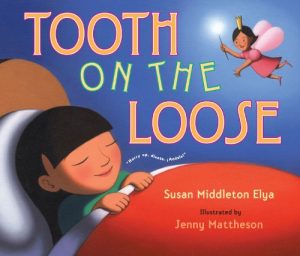 An original take on losing a tooth. This little girl has tried everything to make her loose tooth come out before her dad’s birthday (except letting her brother yank it) so she’ll have money to buy him a gift. Nothing has worked and now it’s the big day. She just can’t go to his party empty handed! At the last second, her mom helps her think of a gift that doesn’t require any money—just imagination and heart. I have no dinero, this card’s all I’ve got. But, Papi, te quiero, I love you a lot. And her dad couldnÂ’t be happier. Susan Middleton Elya’s trademark mix of Spanish vocabulary and fun verse combined with vibrant paintings by Jenny Mattheson will inspire lots of homemade gifts (and patience with loose teeth).
An original take on losing a tooth. This little girl has tried everything to make her loose tooth come out before her dad’s birthday (except letting her brother yank it) so she’ll have money to buy him a gift. Nothing has worked and now it’s the big day. She just can’t go to his party empty handed! At the last second, her mom helps her think of a gift that doesn’t require any money—just imagination and heart. I have no dinero, this card’s all I’ve got. But, Papi, te quiero, I love you a lot. And her dad couldnÂ’t be happier. Susan Middleton Elya’s trademark mix of Spanish vocabulary and fun verse combined with vibrant paintings by Jenny Mattheson will inspire lots of homemade gifts (and patience with loose teeth).
Sophie’s Trophy
Sophie’s brother has a mantel full of awards for his cute warts— verrugas—and shiny skin, but Sophie isn’t nearly as good looking and doesn’t have any trophies at all. One day, while Sophie is singing about her sorrows, the Toadettes are impressed and ask her to join their group. They convince her to do a solo at the fair when the rest of the group gets sick from eating bad flies. You can guess who finally gets a trophy of her own that night. Susan Elya’s seamless verse that includes Spanish vocabulary and Viviana Garofoli’s vivid, lively illustrations makes Sophie’s story one all kids will relate to while they search for their special talents.
Bebe Goes To The Beach
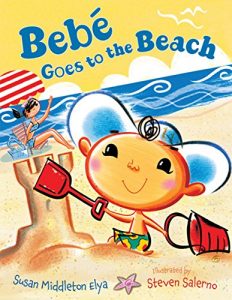 Mama leaves the shopping behind to spend a relaxing day at the beach. But sweet Bebe won’t sit still! He toddles after the waves, chases a bouncing pelota, and even surfs on a sand sculpture. When Bebé finally tuckers out, Mama gets her chance to soak up el sol. Mama and Bebe spiced things up in their first book together, Bebe Goes Shopping–and now they’re at it again! Includes a glossary of Spanish words.
Mama leaves the shopping behind to spend a relaxing day at the beach. But sweet Bebe won’t sit still! He toddles after the waves, chases a bouncing pelota, and even surfs on a sand sculpture. When Bebé finally tuckers out, Mama gets her chance to soak up el sol. Mama and Bebe spiced things up in their first book together, Bebe Goes Shopping–and now they’re at it again! Includes a glossary of Spanish words.
Papa and Me
When I’m with my papá, I can fly like an eagle, an águila.
I can climb alto, high, in a tree,
And I am the ganador, the winner, of many races.
When I am with my papá, I hear the best cuentos, stories,
and I give him the biggest abrazos, hugs.
A young boy and his papa may speak both Spanish and English, but the most important language they speak is the language of love. Here, Arthur Dorros portrays the close bond between father and son, with lush paintings by Rudy Gutierrez.
Before You Were Here, Mi Amor
Before you were here, tu papi carved a mecedora from the wood of an old walnut tree so you and I could rock and cuddle together. The members of a familia lovingly prepare for a new bebé. A tenderly written story, with Spanish words woven throughout, tells readers how Mami is eating healthy food, Papi is building a rocking chair, Abuela is painting elefantes and tigres, in the nursery, and brother and sister are helping with baby names. With its vibrant and warm illustrations, this picture book is perfect for expectant parents or children curious about the time before they were here.
A Box Full of Kittens
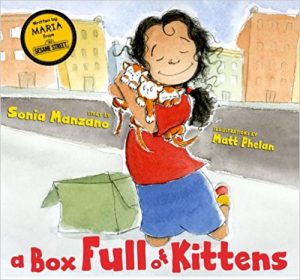 Ruthie loves Superman. Ruthie wants to be Superman. And when Ruthie is asked to go spend the afternoon with her aunt, who is about to have a baby any day day now and may need some help., Ruthie seizes the opportunity. It could be her chance to be a hero, should the baby come while she’s visiting! But when Ruthie is out fetching a snack for her aunt, she gets so distracted by a box full of kittens in the bodega that she doesn’t hear her aunt calling for her, nor does she notice the policemen running to the apartment or the ambulance pulling to the curb. When she realizes what’s happened, she’s devastated — she’s missed her one chance to be a hero! Or has she? Sonia Manzano, best known as “Maria” on Sesame Street, once again captures the warmth, love, and adventures of her childhood Bronx neighborhood.
Ruthie loves Superman. Ruthie wants to be Superman. And when Ruthie is asked to go spend the afternoon with her aunt, who is about to have a baby any day day now and may need some help., Ruthie seizes the opportunity. It could be her chance to be a hero, should the baby come while she’s visiting! But when Ruthie is out fetching a snack for her aunt, she gets so distracted by a box full of kittens in the bodega that she doesn’t hear her aunt calling for her, nor does she notice the policemen running to the apartment or the ambulance pulling to the curb. When she realizes what’s happened, she’s devastated — she’s missed her one chance to be a hero! Or has she? Sonia Manzano, best known as “Maria” on Sesame Street, once again captures the warmth, love, and adventures of her childhood Bronx neighborhood.

